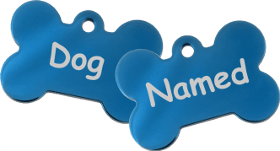1660s Dog Names - Page 3
Updated: July 05, 2024
Welcome to a fascinating journey into the past! In this specific page, we're taking you back to the 1660s, a time when dogs were not just pets, but loyal companions, hunting aides, and cherished family members. Unearth names from a time filled with rich history and cultural shifts. It's a unique chance to name your new pup with a moniker that has survived the test of time.
Experience the charm of the old world as you browse through our curated collection of canine appellations from the 17th century. Each name reflects the distinct culture, values, and events of the era, offering a glimpse into the dog owners' lives during this time. As you browse, you may notice historical influences and trends that have shaped today's popular names. Using a name from the 1660s for your pet can be a beautiful tribute to the past while giving your pet a unique and timeless identity.
Whether you're a history enthusiast, a lover of vintage names, or simply looking for something unique and meaningful for your furry friend, you're in the right place. Let's go back in time together and find that perfect name for your beloved pet.
| Name | Reason to Choose |
|---|---|
| Indigo | The 1660s saw the expansion of trade routes, including those for exotic goods like indigo dye |
| Inkwell | Writing tools were common names |
| Iris | The iris, a common and beautiful flower, was popular in the 1660s |
| Ivory | Ivory was a common material used in the 1660s for various items, including cutlery handles and piano keys |
| Jewel | Jewel refers to the extravagant accessories worn by the nobility in the 1660s |
| Juno | In the 1660s, mythology was widely studied and the Roman goddess Juno was well known |
| Kepler | Names were often inspired by scientists |
| Kettle | Kettles were a common household item used for cooking and boiling water |
| Lace | Lace was a popular fabric in the 1660s, used to adorn clothing and homes |
| Lantern | In the 1660s, lanterns were the primary source of light after sundown |
| Leather | Leather was a common material used for various goods in the 1660s |
| Legacy | Legacy represents the historical significance and enduring impact of the 1660s |
| Loom | Looms were used to weave cloth in the 1660s |
| Louis | Louis XIV, the Sun King, reigned in France during the 1660s |
| Loyal | Reflects the political loyalties of the period |
| Lute | The lute was a popular musical instrument in the 1660s |
| Mace | Mace was a common spice used in cooking and medicine in the 1660s |
| Majesty | Majesty reflects the grandeur and opulence of royal courts in the 1660s |
| Mariner | Sea voyages were a major part of life |
| Marrow | Marrow, found inside bones, was a common food source |
| Mayflower | The Mayflower brought the first English Puritans, known today as Pilgrims, to North America in the 1620s, the influence of which was strong in the 1660s |
| Mead | Mead, a drink made from fermented honey, was popular in the 1660s |
| Mercy | Virtue names were common in this era |
| Milton | Named after the famous poet John Milton |
| Monarch | Represents the ruling system of the time |
| Musketeer | Inspired by the military forces of the time |
| Navigator | Reflects the exploratory spirit of the era |
| Newport | Names were often derived from places |
| Newton | Inspired by the famous physicist Isaac Newton |
| Noble | Noble reflects the societal hierarchy of the 1660s, with nobility at the top |
|
Suggest:
|
Submitted!
|
| 1 2 3 4 5 | |
Inventions/Discoveries
| Name | Description |
|---|---|
| Archimedes | For Archimedes, a mathematician, physicist, and engineer |
| Barometer | An instrument, invented in the 1660s, that measures atmospheric pressure |
| Boyle | Named after Robert Boyle, a pioneer of modern chemistry |
| Buckingham | After the Duke of Buckingham, who sponsored many inventors |
| Celsius | A temperature scale used by scientists, named after its inventor |
| Copernicus | For Nicolaus Copernicus, who theorized about the heliocentric model |
| Descartes | Named after René Descartes, a philosopher and mathematician |
| Dial | Referring to the pendulum clock with a dial invented in this period |
| Euclid | Named after the father of geometry, Euclid |
| Fahrenheit | Named after Daniel Gabriel Fahrenheit, inventor of the Fahrenheit scale |
| Fibonacci | Named after the mathematician who introduced the Fibonacci sequence |
| Galileo | Named after Galileo Galilei, the father of observational astronomy |
| Gravity | Isaac Newton discovered the laws of gravity during this era |
| Halley | For Edmond Halley, who studied comets in the 1660s |
| Hooke | For Robert Hooke, who made key advancements in the field of microscopy |
| Huygens | Named after Christiaan Huygens, the inventor of the pendulum clock |
| Kepler | Named after Johannes Kepler, who made key astronomical discoveries |
| Leibniz | Named after Gottfried Leibniz, a key figure in philosophy and mathematics |
| Mercury | Used in barometers invented during the 1660s |
| Microscope | An essential tool in biology and medicine, improved upon during this era |
| Newton | In honor of Sir Isaac Newton, a key figure in the scientific revolution |
| Pascal | Named after Blaise Pascal, a prominent scientist and mathematician |
| Pendulum | Invented by Christiaan Huygens in the 1660s, revolutionizing timekeeping |
| Telescope | An important invention in the 1660s for observing distant objects |
| Tycho | For Tycho Brahe, a key figure in observational astronomy |
|
Suggest:
|
Submitted!
|
Cultural Names
| Name | Description |
|---|---|
| Baroque | The 1660s was part of the Baroque period, making this a culturally significant name |
| Cavalier | The Cavaliers were a faction in the English Civil War, a major event of the 1660s |
| Corneille | Inspired by Pierre Corneille, a leading French dramatist of the 17th century |
| Cromwell | Inspired by Oliver Cromwell, a key figure in English history during the 1660s |
| DaVinci | Although Leonardo Da Vinci lived before the 1660s, his influence stretched into and beyond this period |
| Galileo | Honors the groundbreaking Italian astronomer who made significant strides in the 17th century |
| Gulliver | A nod to Jonathan Swift's 'Gulliver's Travels', a major literary work of the period |
| Habsburg | The 1660s were a time of Habsburg domination, a powerful European royal house |
| Indigo | Reflects the 1660s trade of indigo dye, crucial to the global economy |
| Lillibullero | A popular English song during the 1660s, it makes for a unique pet name |
| Mayflower | Named after the famous ship that sailed the Pilgrims to America |
| Molière | A tribute to the celebrated French playwright active in the 17th century |
| Newton | Recognizes Sir Isaac Newton, who made significant scientific discoveries during this period |
| Pascal | Named after Blaise Pascal, a key figure in 17th century philosophy and science |
| Pepys | Samuel Pepys, a notable English diarist, provides inspiration for this name |
| Piet | A common Dutch name, reflecting the Netherlands' Golden Age in the 1660s |
| Pilgrim | This name reflects the period of early American history and pioneer spirit |
| Puritan | This name is a nod to the religious group that was prominent in the 1660s |
| Quaker | This religious group was establishing itself in America during the 1660s |
| Rembrandt | Named after the famous Dutch painter from the 17th century |
| Restoration | Marks the Restoration period in England, which began in the 1660s |
| Spinoza | Named after Baruch Spinoza, an influential philosopher of the period |
| Stuart | The House of Stuart was in power in England during the 1660s |
| Vermeer | A tribute to Johannes Vermeer, a Dutch painter from the Baroque period |
| Versailles | Construction of the iconic French palace began in the 1660s |
|
Suggest:
|
Submitted!
|
Geographical Names
| Name | Description |
|---|---|
| Alps | For a dog as majestic as the Alps mountain range in Europe |
| Amazon | The Amazon Rainforest and river were major geographical discoveries |
| Andes | Derived from the Andes Mountains, a prominent geographical feature during the 1660s |
| Arctic | A perfect name for a white or fluffy dog, after the Arctic region |
| Atlas | Named after the Atlas Mountains in Africa |
| Bering | Inspired by the Bering Sea between Alaska and Russia |
| Canary | Named after the Canary Islands, a popular destination in the 1660s |
| Caspian | In honour of the Caspian Sea, the largest enclosed inland body of water |
| Danube | Taken after the Danube River, Europe's second longest river |
| Equator | For a dog that loves warmth, named after the Earth's equator |
| Euphrates | After the Euphrates River, a historically significant waterway |
| Everest | The world's highest mountain peak makes a grand name |
| Gobi | A nod to the Gobi Desert in Asia |
| Himalaya | Taken from the majestic Himalayan Mountain range in Asia |
| Indus | Inspired by the Indus Valley Civilization around the Indus River |
| Nile | Named after the famous river in Egypt, known to the world since ancient times |
| Orient | Symbolizing the mystical and exotic East |
| Pacific | The Pacific Ocean was a heavily explored region during the 1660s |
| Rio | For the dog who loves water, named after the many rivers in the world |
| Sahara | A nod to the vast Sahara Desert, a significant geographical feature |
| Savannah | Inspired by the open grasslands in many parts of the world |
| Siberia | For a dog with a cool disposition, named after the cold Siberian region |
| Thames | Taken from the River Thames, a major waterway in England |
| Tundra | A great name for a large, powerful dog, named after the vast tundra regions |
| Yukon | Inspired by the Yukon River in North America |
|
Suggest:
|
Submitted!
|
Historical Figures
| Name | Description |
|---|---|
| Bernini | This name references Gian Lorenzo Bernini, a prominent Italian sculptor |
| Boyle | Honoring Robert Boyle, a key figure in the early scientific method development |
| Bunyan | John Bunyan, the author of 'The Pilgrim's Progress', inspires this name |
| Corneille | Honoring Pierre Corneille, a leading French dramatist of the time |
| Descartes | For René Descartes, a philosopher and mathematician of the period |
| Dryden | This pays tribute to John Dryden, the first Poet Laureate of England |
| Galileo | Named after Galileo Galilei, a forefather of modern science |
| Hobbes | In honor of Thomas Hobbes, an influential English philosopher |
| Hooke | Robert Hooke, a notable scientist of the time, is the inspiration here |
| Huygens | Christiaan Huygens, a Dutch physicist and astronomer, inspires this name |
| Leibniz | Gottfried Leibniz, a German philosopher and mathematician, is the inspiration |
| Lely | After Sir Peter Lely, a popular portrait painter during the Restoration |
| Locke | Paying homage to John Locke, a major Enlightenment thinker |
| Marvell | Named for Andrew Marvell, an English poet of this era |
| Milton | John Milton, who wrote 'Paradise Lost' in this era, is the namesake |
| Moliere | This name derives from Moliere, the French playwright active during the 1660s |
| Newton | Named after Sir Isaac Newton, a prominent figure in the scientific revolution of the 17th century |
| Pascal | For Blaise Pascal, a mathematician and philosopher of the time |
| Pepys | This refers to Samuel Pepys, a famous English diarist of the 1660s |
| Poussin | Referring to Nicolas Poussin, a French painter of the Baroque era |
| Racine | Jean Racine, a prominent French dramatist, is the namesake |
| Rembrandt | A nod to the Dutch painter, who was active during this period |
| Spinoza | Named after Baruch Spinoza, a philosopher of the period |
| Vermeer | Commemorates the famed 1660s Dutch artist, Johannes Vermeer |
| Wren | In honor of Sir Christopher Wren, a renowned architect of the era |
|
Suggest:
|
Submitted!
|
Names from Literature
| Name | Description |
|---|---|
| Algernon | A name taken from the character in 'The Importance of Being Earnest' |
| Bennet | A family name in Jane Austen's 'Pride and Prejudice' |
| Bingley | A friendly character from 'Pride and Prejudice' makes a lovely pet name |
| Crusoe | Inspired by the protagonist in the 1719 novel 'Robinson Crusoe' |
| Darcy | Derived from the prideful character Mr. Darcy in 'Pride and Prejudice' |
| Eyre | Inspired by the independent character of Jane Eyre |
| Fagin | A character from Charles Dickens' 'Oliver Twist' |
| Gulliver | A name taken from the protagonist in 'Gulliver's Travels' |
| Havisham | From the character Miss Havisham in 'Great Expectations' |
| Heathcliff | From the tumultuous character in Emily Bronte's 'Wuthering Heights' |
| Hester | This 1850 'The Scarlet Letter' character makes a strong name option |
| Huck | A nod to the adventurous character of Huckleberry Finn from Mark Twain's classic |
| Hyde | Inspired by the character from Robert Louis Stevenson's 'Dr. Jekyll and Mr. Hyde' |
| Ichabod | A notable character from Washington Irving's 'The Legend of Sleepy Hollow' |
| Lilliput | From the tiny island in 'Gulliver's Travels' |
| Mowgli | The jungle boy from Rudyard Kipling's 'The Jungle Book' |
| Oliver | From the orphaned protagonist in 'Oliver Twist' |
| Othello | An intriguing Shakespearean protagonist |
| Pip | The main character from 'Great Expectations' makes a charming pet name |
| Quixote | Named after the delusional knight in the novel 'Don Quixote' |
| Rochester | An intriguing character from the novel 'Jane Eyre' written in 1847 |
| Sancho | Named after Sancho Panza, a character in the 17th century novel 'Don Quixote' |
| Sherlock | For lovers of Sir Arthur Conan Doyle's detective novels |
| Silas | From George Eliot's 'Silas Marner', a 1861 novel |
| Watson | After the loyal character Dr. Watson in the Sherlock Holmes series |
|
Suggest:
|
Submitted!
|
User Submitted Images
There are currently no user submitted images for this page. This is your opportunity to be the first! Submit your photo below.
User Recommendations
There are currently no name recommendations for this page. This is your opportunity to be the first! Make your recommendation below.
Recently Updated
We would like to take this time to thank all of our visitors that make DogNamed.com the best dog naming resource on the web. Our site would not be where it is today without your suggestions, ratings, and photo submissions. So pat yourselves on the back for a job well done and keep up the good work! If you have any comments, suggestions, or ideas for the this page or any part of our site, don't hesitate to drop us a line on our Contact Page. Thank you! -The DogNamed Team




























